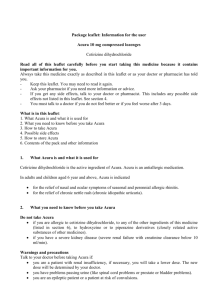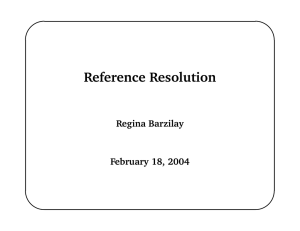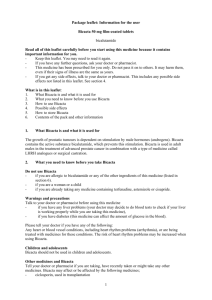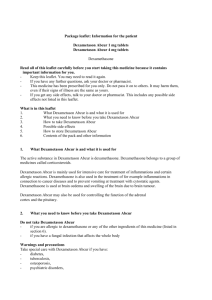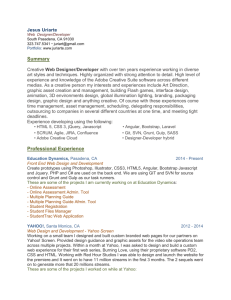Acura 10 mg lozenge ENG PL
advertisement
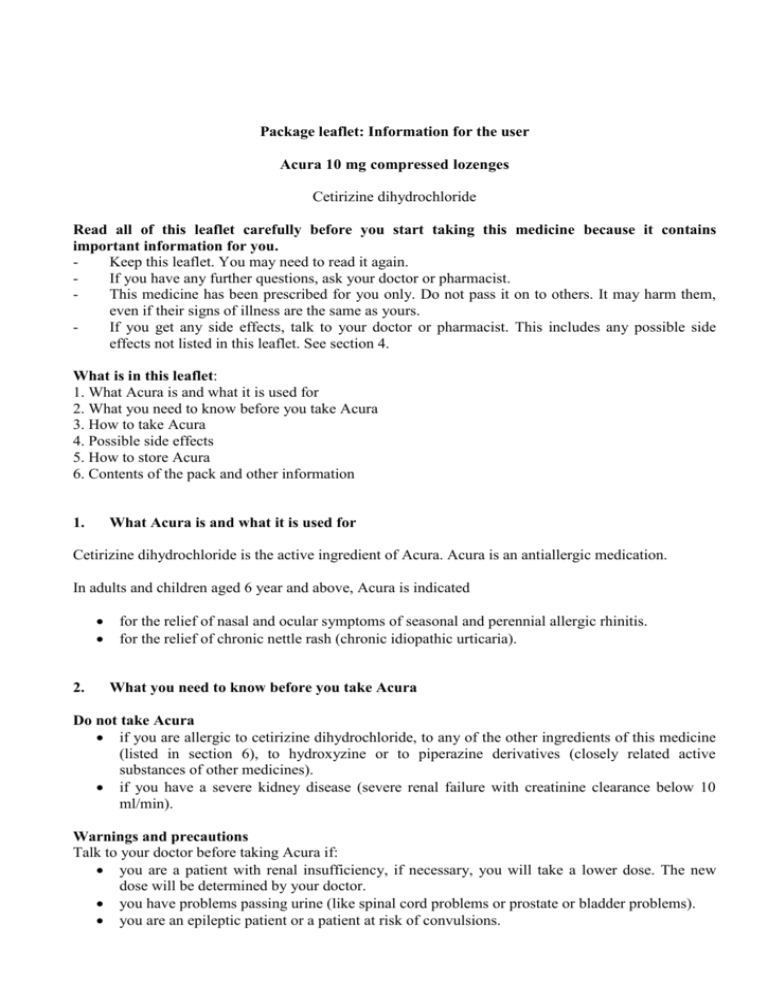
Package leaflet: Information for the user Acura 10 mg compressed lozenges Cetirizine dihydrochloride Read all of this leaflet carefully before you start taking this medicine because it contains important information for you. Keep this leaflet. You may need to read it again. If you have any further questions, ask your doctor or pharmacist. This medicine has been prescribed for you only. Do not pass it on to others. It may harm them, even if their signs of illness are the same as yours. If you get any side effects, talk to your doctor or pharmacist. This includes any possible side effects not listed in this leaflet. See section 4. What is in this leaflet: 1. What Acura is and what it is used for 2. What you need to know before you take Acura 3. How to take Acura 4. Possible side effects 5. How to store Acura 6. Contents of the pack and other information 1. What Acura is and what it is used for Cetirizine dihydrochloride is the active ingredient of Acura. Acura is an antiallergic medication. In adults and children aged 6 year and above, Acura is indicated 2. for the relief of nasal and ocular symptoms of seasonal and perennial allergic rhinitis. for the relief of chronic nettle rash (chronic idiopathic urticaria). What you need to know before you take Acura Do not take Acura if you are allergic to cetirizine dihydrochloride, to any of the other ingredients of this medicine (listed in section 6), to hydroxyzine or to piperazine derivatives (closely related active substances of other medicines). if you have a severe kidney disease (severe renal failure with creatinine clearance below 10 ml/min). Warnings and precautions Talk to your doctor before taking Acura if: you are a patient with renal insufficiency, if necessary, you will take a lower dose. The new dose will be determined by your doctor. you have problems passing urine (like spinal cord problems or prostate or bladder problems). you are an epileptic patient or a patient at risk of convulsions. If you need to undergo an allergy skin test, you should stop taking Acura at least 3 days in advance since Acura can influence the outcome of the test. No interactions susceptible to have a noticeable impact have been observed between alcohol (at the blood level of 0.5 per mille corresponding to one glass of wine) and cetirizine used at the normal doses. However, as it is the case with all antihistamines, it is recommended to avoid concurrent consumption of alcohol. Children The use of the compressed lozenge is not recommended in children aged less than 6 years since the lozenge does not allow for appropriate dose adaptation. Other medicines and Acura Tell your doctor or pharmacist if you are taking, have recently taken or might take any other medicines. Due to the profile of cetirizine, no interactions with other drugs are expected. Acura with food and drink Food does not affect noticeably the absorption of cetirizine. Pregnancy and breast-feeding If you are pregnant or breast-feeding, think you may be pregnant or are planning to have a baby, ask your doctor or pharmacist for advice before taking this medicine. As with other drugs, use of Acura should be avoided in pregnant women. Accidental use of the drug by a pregnant woman should not produce any harmful effects on the foetus. Nevertheless, the administration of the medicine should be discontinued. You should not take Acura during breast-feeding because cetirizine passes into breast milk. Driving and using machines Clinical studies have produced no evidence of impaired attention, alertness and driving capabilities after taking Acura at the recommended dose. If you are intending to drive, engage in potentially hazardous activities or operate machinery, you should not exceed the recommended dose. You should closely observe your response to the drug. If you are a sensitive patient, you may find that the simultaneous use of alcohol or other nervous depressant agents may additionally affect your attention and ability to react. 3. How to take Acura Always take this medicine exactly as your doctor has told you. Check with your doctor or pharmacist if you are not sure. Suck the lozenge in your mouth until dissolved. Can be taken with or without water. Adults and adolescents above 12 years old: 10 mg once daily as 1 tablet. Children between 6 and 12 years old: 5 mg twice daily as a half tablet twice daily. Patients with moderate to severe renal impairment Patients with moderate renal impairment are recommended to take 5 mg once daily. If you feel that the effect of Acura is too weak or too strong, please consult your doctor. Duration of treatment The duration of treatment depends on the type, duration and course of your complaints and is determined by your doctor. If you take more Acura than you should If you think you have taken an overdose of Acura please inform your doctor. Your doctor will then decide what measures, if any, should be taken. After an overdose, the side effects described below may occur with increased intensity. Adverse effects such as confusion, diarrhoea, dizziness, tiredness, headache, ailing, dilating of pupil, itching, restlessness, sedation, somnolence, stupor, abnormal rapid heart rate, tremors and urinary retention have been reported. If you forget to take Acura Do not take a double dose to make up for forgotten dose. If you have any further questions on the use of this medicine, ask your doctor or pharmacist. 4. Possible side effects Like all medicines, this medicine can cause side effects, although not everybody gets them. Stop taking Acura and seek for medical attention without delay if you experience symptoms like: swelling in your mouth, face and/or throat difficulties in breathing (chest tightness or wheezing) sudden drop in your blood pressure with subsequent fainting or shock The symptoms can be signs of hypersensitivity reactions, anaphylactic shock and angio-oedema. These reactions are rare (may affect up to 1 in 1000 people). The following side effects have also been reported. Common (may affect up to 1 in 10 people) - fatigue - dry mouth, nausea - dizziness, headache - somnolence - pharyngitis (sore throat), rhinitis Uncommon (may affect up to 1 in 100 people) - abdominal pain - asthenia (extreme fatigue), malaise - paresthesia (abnormal feelings of the skin) agitation pruritus, rash diarrhoea Rare (may affect up to 1 in 1,000 people) - tachycardia (heart beating too fast) - oedema (swelling) - liver function abnormal - weight increased - convulsions - aggression, confusion, depression, hallucination, insomnia - urticaria Very rare (may affect up to 1 in 10,000 people) - thrombocytopenia (low levels of blood platelets) - accommodation disorder, blurred vision, oculogyration (eyes having uncontrolled circular movements) - syncope, tremor, dysgeusia (altered taste), movement disorder for example involuntary muscle movements (dystonia, dyskinesia) - tics - abnormal elimination of urine - fixed drug eruption Not known (frequency cannot be estimated from the available data). - vertigo (sensation of rotation or movement) - increased appetite - amnesia, memory impairment - suicidal ideation (recurring thoughts of or preoccupation with suicide) - urinary retention (inability to completely empty the urinary bladder) Reporting of side effects If you get any side effects, talk to your doctor or pharmacist. This includes any possible side effects not listed in this leaflet. You can also report side effects directly via the national reporting system listed in Appendix V. By reporting side effects you can help provide more information on the safety of this medicine. 5. How to store Acura Keep this medicine out of the sight and reach of children. Store in the original package in order to protect from moisture. Do not use this medicine after the expiry date which is stated on the box and blister after EXP. The expiry date refers to the last day of that month. Do not throw away any medicines via wastewater or household waste. Ask your pharmacist how to throw away medicines you no longer use. These measures will help protect the environment. 6. Contents of the pack and other information What Acura contains The active substance is cetirizine dihydrochloride. One compressed lozenge contains 10 mg cetirizine dihydrochloride. The other ingredients are betadex (E459), povidone K-25, sodium cyclamate (E952), cellulose powder (E460), monosodium citrate (E331), microcrystalline cellulose (E460), magnesium stearate (E470B) and synthetic apple flavour. What Acura looks like and contents of the pack Round, white to almost white compressed lozenge with a break-mark on both sides. The compressed lozenge can be divided into equal halves. Pack with 7, 10, 14, 20, 21, 28, 30 or 100 compressed lozenges. Not all pack sizes may be marketed. Marketing Authorisation Holder and Manufacturer <to be completed nationally> This medicinal product is authorised in the Member States of the EEA under the following names: Sweden Acura 10 mg komprimerad sugtablett Finland Gardex 10 mg imeskelytabletit This leaflet was last revised in 1 October 2014
